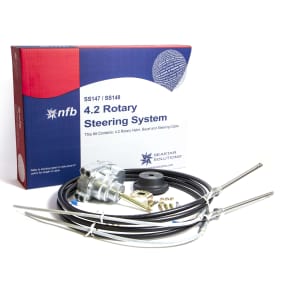
NFB 4.2 Rotary Steering Dual Cable Kit - with 15 ft Cables
Description
While single cable steering kits are suitable for well-behaved, single station, non-power-assisted^ outboard and sterndrive engines up to V-6, this rugged dual cable system is made for any of these installations that exhibit excessive engine flutter or steering instability.
These SeaStar Solutions dual cable 4.2 Rotary NFB Steering kits offers the advantage of 4.2 turns lock-to-lock plus patented No FeedBack* Steering Control for about a hundred bucks over the cost of an old-fashioned steering replacement.
The advantage of 4.2 turns lock-to-lock over the 3.0 turns is that you will exert less effort when steering, although the turning response time will be slower. This helm offers more fine tuning and control when steering.
The advantage of Dual Cables —
All mechanical steering systems rely on a push-pull cable to do the work of moving the drive unit. The steering efficiency (percentage of your steering effort that actually gets transferred to the drive housing) depends to a large extent on the amount of backlash in the cable.
All cables - even the best - have some degree of backlash (or lost motion). Lost motion is the difference between the amount of movement at the input end of the cable compared to the movement at the output end due to internal bending motion between the cable's inner core and its outer conduit.
Backlash is experienced by the operator as free play (slop) in the steering wheel.
While some degree of backlash is acceptable on most boats, certain higher performance boat/engine combinations exhibit engine flutter and steering instability when there is a high degree of backlash. The instability becomes magnified at higher speeds - especially above 50 mph.
Dual cable mechanical steering systems are recommended by SeaStar Solutions as well as engine manufacturers for these boats.
With dual cable steering systems, one cable can be adjusted to counteract the backlash in the other cable when turning in one direction, and vice versa. This negates most of the backlash effect — reducing engine flutter and the resulting handling instability.
NFB Dual Cable Steering Kit Features —
• Patented No FeedBack™ steering mechanism
• Comfortable 4.2 turns lock-to-lock provides precise steering
• Twin cable system available for maximum control
• Standard 3/4" tapered shaft
• Stainless steel cable output ends resist corrosion
• Fast, easy installation using Quick connect (QC) steering cable(s)
• Meets ABYC standards and NMMA certification requirements
What's in the box...
Kits include — dual cable NFB 4.2 helm (SH4920P), 90° bezel (SB27150P), mounting hardware, and (2) QC Cables (SSC62xx) (the "xx" in the part number is the length of the cable in feet.
Note: an optional Tilt Helm unit (SH91527P) is available for this steering kit. (Requires purchase of tilt mechanism SH91800P or SH91900P.) Please contact Fisheries Supply for details at 800-426-6930.
* What is NFB?
NFB stands for "No FeedBack", and is an exclusive feature built into SeaStar Solutions helms to fight propeller torque feedback.
In standard mechanical steering systems, the turning of the propeller creates a torque force which can be felt in the steering wheel as a tendancy for the boat to constantly want to turn in one direction. To keep the boat going straight, this veering must be constantly "fought" by the person steering the boat.
A corollary effect is that the boat can be turned in one direction with just one finger, but requires two hands to turn in the other direction. This is especially apparent with larger engines (over 40 - 50 horsepower), as well as at higher speeds.
For about a hundred bucks more than a standard helm mechanism, SeaStar Solutions NFB helms incorporate an internal clutch mechanism that grips the steering shaft whenever you are not actively steering. This significantly decreases the tiresome effect of prop torque — without having to spend an extra thousand dollars for an hydraulic system to completely eliminate the feedback.
When you take your hands off the wheel with a standard mechanical steering system the boat will quickly start to turn of its own accord. With an NFB system, that turning tendency will be much slower to start and can be controlled with less effort.
An hydraulic system, on the other hand, will completely eliminate propeller torque feedback, so you can take your hands off the wheel, and the boat will continue to track straight (all other things being equal).
Hydraulic steering is a real advantage with larger engines, and is highly recommended for those applications.
In case you were wondering, boats with inboard engines do not experience prop torque since you steer them with a rudder, not by having to turn the entire drive unit and propeller - as with an outboard or I/O.
^NFB steering helms should never be used with autopilots, power-assisted steering systems, or second helm stations.
This is because No Feedback Helm Systems have that internal clutch mechanism, mentioned above, which grips the steering wheel shaft and locks it in place whenever you are not actually turning the steering wheel. Therefore, the steering cables are also locked in place.
Any external mechanism - such as a second helm unit, autopilot, or power-assist - that attempts to adjust the position of the outboard or I/O drive unit (or the attached steering cables) will meet with substantial resistance from the NFB helm clutches, possibly damaging the autopilot or power-assisrt unit.